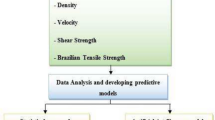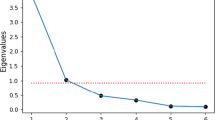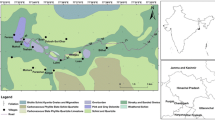Abstract
The engineering properties of rocks play a significant role in planning and designing of mining and civil engineering projects. A laboratory database of mechanical and engineering properties of rocks is always required for site characterization and mineral exploitation. Due to discontinuous and variable nature of rock masses, it is difficult to obtain all physicomechanical properties of rocks precisely. Prediction of unconfined compressive strength from seismic wave velocities (Compressional wave, Shear wave) and density of rock using generalized regression neural network (GRNN) and adaptive neuro-fuzzy inference systems (ANFIS) can be appropriate and alternate methods to minimize the time and cost of tests. GRNN and ANFIS models were trained with 41 data sets using conjugate gradient descent algorithms and hybrid learning algorithm, respectively. Performance of both the models was examined with 15 testing data sets. In the present study, obtained network performance indices such as correlation coefficient, mean absolute percentage error, root mean square error and variance account for indicate high performance of predictive capability of GRNN system and closer to actual data over the ANFIS.







Similar content being viewed by others
Explore related subjects
Discover the latest articles, news and stories from top researchers in related subjects.References
Sharma PK, Singh TN (2008) A correlation between P-wave velocity, impact strength index, slake durability index and uniaxial compressive strength. Bull Eng Geol Environ 67:17–22
Chary KB, Sarma LP, Lakshmi KJP, Vijayakumar NA, Lakshmi VN, Rao MVMS (2006) Evaluation of engineering properties of rock using ultrasonic pulse velocity and uniaxial compressive strength. In: Proceedings of the national seminar on non-destructive evaluation, NDE, pp 379–385
Szlavin J (1974) Relationships between some physical properties of rock determined by laboratory tests. Int J Rock Mech Min Sci Geomech Abs 11:57–66
Vishal V, Pradhan SP, Singh TN (2010) Instability assessment of mine slope-a finite element approach. Int J Earth Sci Eng 3:11–23
Singh TN, Pradhan SP, Vishal V (2012) Stability of slopes in a fire-prone mine in Jharia Coalfield, India. Arab J Geosc. doi:10.1007/s12517-011-0341-4
Vishal V, Pradhan SP, Singh TN (2011) Tensile strength of rock under elevated temperature. Geotech Geol Eng 29:1127–1133
Sarkar K, Vishal V, Singh TN (2012) An empirical correlation of index geomechanical parameters with the compressional wave velocity. Geotech Geol Eng 30:469–479
Singh TN, Kanchan R, Saigal K, Verma AK (2004) Prediction of P-wave velocity and anisotropic property of rock using artificial neural network technique. J Sci Ind Res 63:32–38
Singh TN, Kanchan R, Verma AK, Saigal K (2005) Comparative study of ANN and neuro-fuzzy for the prediction of dynamic constant of rockmass. J Earth Syst Sci 114:75–86
Karakus M, Tutmez B (2006) Fuzzy and Multiple regression modelling for evaluation of intact rock strength based on point load. Schmidt hammer and sonic velocity. Rock Mech Rock Eng 39(1):45–57
Vasconcelos G, Lourenço PB, Alves CSA, Pamplona J (2007) Prediction of the mechanical properties of granites by ultrasonic pulse velocity and Schmidt hammer hardness. In: North American Masonry Conference, pp 981–991
Arslan AT, Koca MY, Aydogmus T, Klapperich H, Yılmaz HR (2008) Correlation of unconfined compressive strength with young’s modulus and poisson’s ratio in gypsum from Sivas (Turkey). Rock Mech Rock Eng 41(6):941–950
Khandelwal M, Singh TN (2009) Correlating static properties of coal measures rocks with P-wave velocity. Int J Coal Geol 79:55–60
Garrett J (1994) Where and why artificial neural networks are applicable in civil engineering. J Comput Civil Eng 8:129–130
Matlab Manual (2009) Fuzzy logic toolbox™ user’s guide
Specht DF (1991) A general regression neural network. IEEE Trans Neural Net 2(6):568–576
Chen TC, Yu CH (2009) Generalized regression neural-network-based modeling approach for traveling-wave ultrasonic motors. Electr Power Comput Syst 37(6):645–657
Zadeh LA (1965) Fuzzy sets. Inform Contr 8:338–353
Finol J, Guo YK, Jing XD (2001) A rule based fuzzy model for the prediction of petrophysical rock parameters. J Petrol Sci Eng 29:97–113
Gokceoglu C (2002) A fuzzy triangular chart to predict the uniaxial compressive strength of the Ankara agglomerates from their petrographic composition. Eng Geol 66:39–51
Gokceoglua C, Zorlu K (2004) A fuzzy model to predict the uniaxial compressive strength and the modulus of elasticity of a problematic rock. Eng Appl Art Int 17:61–72
Takagi H, Hayashi I (1991) NN-driven fuzzy reasoning. Int J Approx Reason 5:191–212
Pedrycz W (1984) An identification algorithm in fuzzy relational systems. Fuzzy Set Syst 13:153–167
Mandani EH, Assilan S (1975) An experiment in linguistic synthesis with a fuzzy controller. Int J Man Mach Stud 7(1):1–13
Lin CT, Lee CS (1991) Neural network based fuzzy logic control and decision system. IEEE Trans Comput 40:1320–1336
Jang JSR (1992) Fuzzy controllers based on temporal back propagation. IEEE Trans Neural Net 3:714–723
Takagi T, SugenoM (1985) Fuzzy identification of systems and its applications to modeling and control. IEEE Trans Syst Man Cybern SMC-15 1:116–132
Sugeno M, Kang GT (1988) Structure identification of fuzzy models. Fuzzy Set Syst 28:15–33
Tahmasebi P, Hezarkhani A (2010) Application of adaptive neuro-fuzzy inference system for grade estimation; case study, sarcheshmeh porphyry copper deposit, Kerman, Iran. Aust J Basic Appl Sci 4(3):408–420
Grima MA, Bruines PA, Verhoef PNW (2000) Modeling tunnel boring machine performance by neuro-fuzzy methods. Tunn Under Space Tech 15(3):259–269
Jang JSR (1993) ANFIS: adaptive-network-based fuzzy inference system. IEEE Trans Syst Man Cybern 23(3):665–685
Monjezi M, Dehghani H (2008) Evaluation of effect of blasting pattern parameters on back break using neural networks. Int J Rock Mech Min Sci 45:1446–1453
Singh R, Vishal V, Singh TN (2012) Soft computing method for assessment of compressional wave velocity. Scientia Iranica (revision under review)
Verma AK, Singh TN (2012) Comparative study of cognitive systems for ground vibration measurements. Neural Comput Appl. doi:10.1007/s00521-012-0845-1
Author information
Authors and Affiliations
Corresponding author
Rights and permissions
About this article
Cite this article
Singh, R., Vishal, V., Singh, T.N. et al. A comparative study of generalized regression neural network approach and adaptive neuro-fuzzy inference systems for prediction of unconfined compressive strength of rocks. Neural Comput & Applic 23, 499–506 (2013). https://doi.org/10.1007/s00521-012-0944-z
Received:
Accepted:
Published:
Issue Date:
DOI: https://doi.org/10.1007/s00521-012-0944-z




